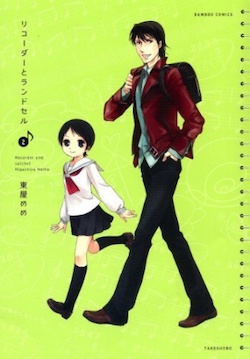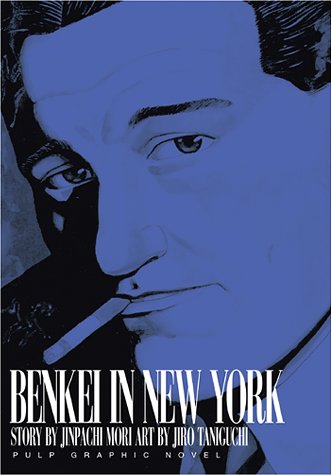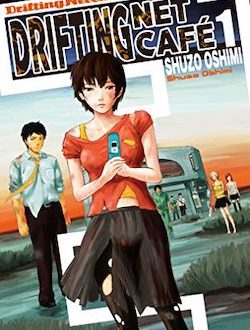Most of the 4-koma manga I’ve read have been stamped from the same mold. There’s a quartet of teenage girls, each of whom has one personality trait, one talent or obsession, and one distinguishing physical characteristic. They all attend the same cram school, or live in the same dorm, and participate in the same everyday activities: studying for tests, planning trips to the beach, baking cakes. What passes for humor arises mostly from the clash of personalities or interests: the klutz accidentally pours water on the neat freak’s homework, or the brain chastises the compulsive gamer for playing another round of Warcraft instead of hitting the books.
Recorder and Randsell is an interesting variation on this theme, replacing the quartet of girls with mismatched siblings: Atsumi, a high school sophomore who looks eight, and Atsushi, a fifth grader who looks like a college student.
As one might guess from the characters’ appearance, most of the jokes revolve around mistaken identity. Atsumi’s best friend, the well-developed Sayo, pretends that Atsumi is her daughter to keep creepy guys at bay, while Atsushi’s grade-school pals dress him up as a parent so they can attend a cultural festival without a chaperone. Not all of the humor is PG-rated: in one of the series’ many running gags, Atsushi’s pretty young teacher is flustered by her student’s deceptively mature physique, her humiliation compounded by strangers mistakenly assuming that the puppy-like Atsushi is, in fact, her boyfriend.
To be sure, many 4-koma titles are built on the same foundation as Recorder and Randsell: the characters are easy to grasp; they follow clearly established patterns of behavior; and they seldom learn from their mistakes. What makes Recorder and Randsell funny is Higeyashi’s ability to devise new scenarios that yield the same disastrous outcomes; no matter what Atsumi and Atsushi do, or where they go, other people misread their respective ages. Higeyashi is also unconcerned with making her characters lovable, which grants her license to be weird, edgy, and a little mean to them — something that almost never happens in Sunshine Sketch or Ichiroh!!, where the characters’ behavior is carefully calibrated to trigger the reader’s awwwwwwwww reflex.
Also working in Recorder and Randsell‘s favor is the small but well-defined supporting cast. Meme Higeshiya gives each of these characters a clear role to play: Atsushi’s sidekicks, for example, remind us that Atsushi is on the brink of becoming a teenager, as they simultaneously envy the attention Atsushi receives from female classmates and tease him about his size. (“He’s a huge target!” one gleefully declares at the beginning of a dodge ball game.) The best supporting player, however, is Take, the Miyagawa’s next-door neighbor, a thirty-something man who can’t hold a steady job. Though we never see his face, Take is a frequent visitor to the Miyagawa household, unloading unwanted clothing on Atsushi whenever he breaks up with a girlfriend. (“Naoko gave me that shirt… Sachiko picked out those pants… Keiko bought me those shoes,” Take tells a bewildered Atsushi. “Stop or I won’t want to wear them anymore!” Atsushi complains.)
The art, like the script, gets the job done. Higeshiya plays up the physical contrast between the siblings, rendering Atsumi as a tiny, doll-faced girl with enormous eyes and Atsushi as a tall shojo prince. On closer inspection, the reader will see that Higeyashi is skillful enough to capture her characters’ respective ages through their body language and facial expressions; Atsushi clearly comports himself like a child, with wildly exaggerated movements and quicksilver moods, while Atsumi assumes the scolding posture of an adult.
I’d be the first to admit that such a slender premise couldn’t sustain a eight- or ten-volume series; by the fifth time the police arrest Atsushi on suspicion of being a pedophile, the punchline falls flat. Read in short bursts, however, the effect is like a good newspaper strip, offering an agreeable mixture of predictable and not-so-predictable jokes. Recommended.
RECORDER AND RANDSELL, VOL. 1 • BY MEME HIGEYASHI • TAKESHOBO CO., LTD. (JMANGA) • 115 pages • RATING: TEEN PLUS (13+)




Derek Bown says:
I was actually watching the anime adaptation of this a while back, right before the milky accident my laptop had. I kinda want to continue it, but I’m afraid it will bring flashbacks to very expensive accidents.
LG says:
Like Derek, I also started watching the anime adaptation. I’m happy that the episodes are so short because, like you said, the premise is pretty slender. The “Police! Go after that child molester!” joke does get a bit old, even after only 7 episodes. Plus, even trying to keep my brain from butting in too much, I can’t help but wonder why the people along Atsushi’s walk home don’t remember that there’s a kid who looks like a man – clearly everyone at his school knows and has adjusted (sort of).
Katherine Dacey says:
Recorder and Randsell works best when you don’t think too hard about it; once you start applying logic, some of the gags fall apart really quickly. Of course, that’s true of a lot of comedy, especially stories that hinge on misunderstandings or mistaken identity.
rob says:
I think there’s a broad range of 4koma out there. It’s a shame it’s such a narrow repetitive scene that reaches the west. Notable exception Shoulder a coffin Kuro. Titles like this show that 4koma doesn’t have to be all slice of life teen humour punchlines and instead the 4 panel format can present brief vignettes which all add up to a bigger more powerful story.
Katherine Dacey says:
Hi, Rob! You’re absolutely right that 4-koma titles aren’t just about cute schoolgirls doing cute things; I am a Turtle and Neko Ramen are two counter-examples that spring to mind. Ditto for Shoulder-a-Coffin, Kuro, which I featured last year in a Best Manga You’re Not Reading column: http://mangacritic.com/2011/01/27/the-best-manga-youre-not-reading-shoulder-a-coffin-kuro/. I’d love to see a greater variety of titles in the format, as I’m sure someone has written the manga equivalent of Peanuts, Calvin and Hobbes, or Pogo.
Sara says:
Hi guys,
I know another manga which isn’t about schoolgirls: ‘Koroshiya-san: The Hired Gun’, by Tamachiku. This manga is about the best assassin in Japan and many other characters, such as a girl who wants to take her revenge (and is a great source of fanservice), two policemen, a guy who wants to be the assassin’s disciple… Some jokes are hilarious, but there’s a big problem: many jokes are thought essentially for Japanese speakers (kanjis jokes, homophone words in Japanese, etc).
Katherine Dacey says:
That sounded awesome — until you mentioned all the wordplay! I can’t imagine how one would translate kanji jokes into English. I’m still amazed that anyone was brave enough to adapt Sayanora, Zetsubou-Sensei for Western audiences, given how culturally and linguistically specific the humor is.
genet says:
Yeah I was honestly shocked when Sayonara, Zetsubou-Sensei was released here. I love it, but I thought it would never show up here.